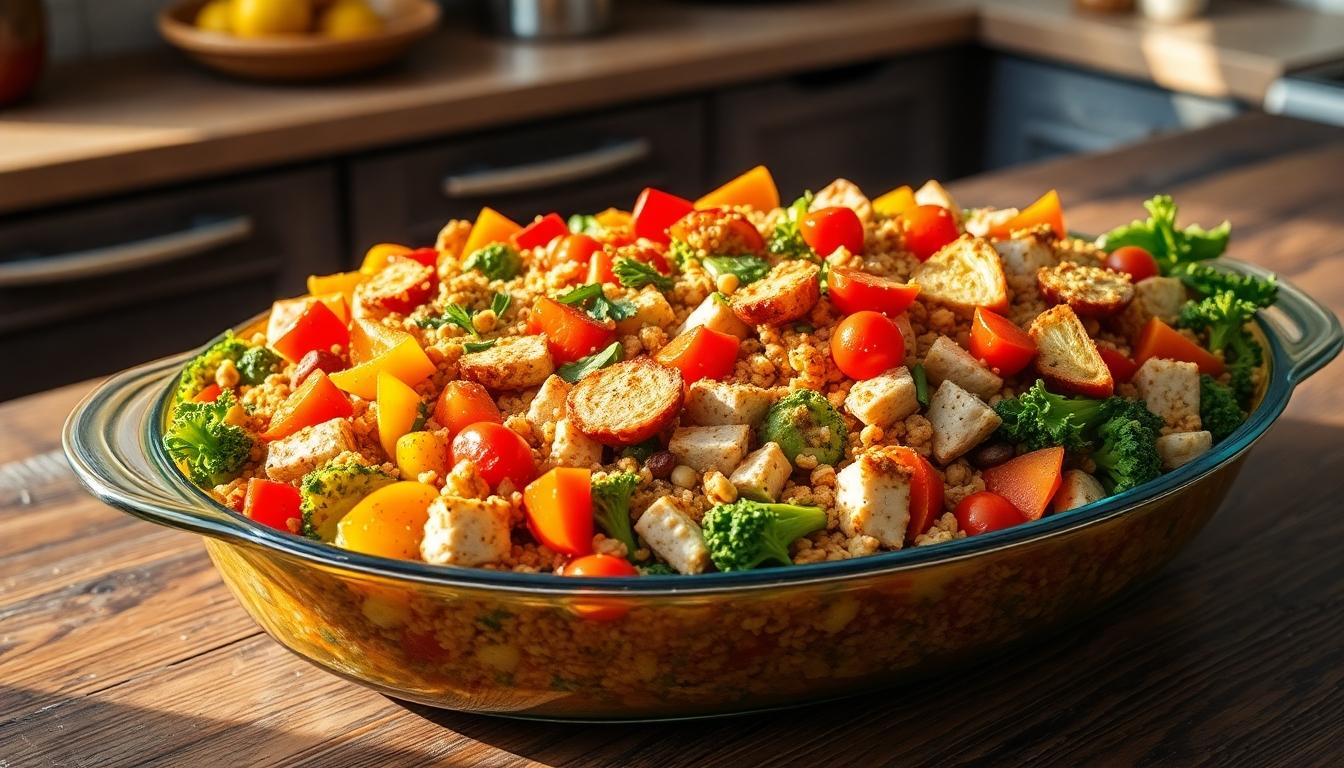Table of Contents
ToggleCasseroles often get a bad rap as the guilty pleasure of comfort food lovers, but they can be the superheroes of healthy eating too! Imagine digging into a piping hot dish that’s not only delicious but also packed with nutrients. It’s time to swap out the heavy cream and cheese for vibrant veggies and lean proteins without sacrificing flavor.
Overview of Healthy Casserole Recipes
Healthy casserole recipes combine taste and nutrition. Casseroles often feature a blend of ingredients, including vegetables, grains, and lean proteins. Seasonal vegetables add vitamins and minerals, enhancing both flavor and health benefits. Lean proteins like chicken, turkey, or beans contribute essential nutrients while keeping the dish light.
Quinoa, brown rice, and whole grain pasta serve as excellent base options. Each provides fiber that promotes fullness and digestion. Incorporating herbs and spices boosts flavor without adding excessive sodium or calories. Examples include garlic, basil, and oregano, which elevate the overall taste profile.
Recipes can also replace high-calorie ingredients with healthier alternatives. For instance, Greek yogurt can substitute for sour cream in creamy casseroles. Low-fat cheese varieties deliver a savory touch while reducing calorie content.
Preparation methods play a role in preserving health benefits. Baking or steaming maintains nutrients better than frying. Many healthy casserole recipes allow for preparation ahead of time, making them convenient for busy lifestyles.
Exploring different cuisines broadens the variety of healthy casserole options. Mexican-style casseroles can utilize black beans, corn, and spices for a nutritious twist. Mediterrenean casseroles often include eggplant, zucchini, and chickpeas, creating a hearty but healthy meal.
Healthy casseroles prove that comfort food can align with nutritious eating. They cater to diverse dietary preferences while offering satisfying meals that don’t compromise health.
Benefits of Casserole Recipes

Casserole recipes offer numerous health benefits while proving to be convenient and satisfying. These dishes encourage the use of wholesome ingredients that nourish the body.
Nutritional Advantages
Nutritional advantages of casseroles include a versatile array of healthy ingredients. Seasonal vegetables often provide essential vitamins and antioxidants. Lean proteins, such as chicken, turkey, or beans, contribute necessary amino acids. Whole grains like quinoa, brown rice, and whole grain pasta supply ample fiber, promoting digestive health. Herbs and spices enhance flavor without adding excess sodium or calories. By replacing high-calorie components with lighter alternatives, individuals can create balanced meals. Casseroles also allow for creativity, as various cuisines offer healthy twists on traditional comfort food.
Meal Prep and Convenience
Meal prep and convenience make casseroles an ideal choice for busy lifestyles. Preparing a casserole in advance allows for easy portioning and reheating throughout the week. Casseroles suit families and individuals, simplifying weeknight dinners. Utilizing one dish minimizes cleanup time, making it practical for anyone. Customizable ingredients ensure that dietary preferences and restrictions are easily accommodated. With minimal effort required, a delicious and nutritious meal can be on the table in no time. Options range from freeze-friendly versions to fresh takes that remain flavorful after storage.
Types of Healthy Casseroles
Healthy casseroles come in various forms, accommodating different tastes and dietary preferences. They can feature hearty vegetables, lean proteins, and whole grains, providing nutritious meals.
Vegetarian Casseroles
Vegetarian casseroles offer a flavorful option packed with plant-based nutrition. Seasonal vegetables like spinach, kale, and bell peppers enhance the dish’s color and vitamins. Ingredients such as quinoa, lentils, and chickpeas add protein and fiber, promoting overall health. Using whole grain pasta or brown rice as a base not only boosts the fiber content but also creates a hearty texture. Incorporating herbs like basil, oregano, and thyme elevates flavors without relying on sodium-heavy seasonings. Vegetarian casseroles are versatile, easily adapted for different cuisines, and perfect for satisfying meal prep.
Meat-Based Casseroles
Meat-based casseroles provide a filling choice rich in lean proteins. Options like chicken, turkey, and fish contribute essential amino acids, fueling the body effectively. Adding nutrient-dense ingredients such as broccoli, carrots, and sweet potatoes enhances the nutritional profile. Whole grains like brown rice or barley serve as excellent bases, offering additional fiber. Flavor profiles can range from zesty Mexican to comforting Italian, with spices and herbs enhancing taste without unnecessary calories. Meat-based casseroles are practical for meal prep, ensuring hearty portions ready for busy weeknights.
Key Ingredients for Healthier Casseroles
Healthy casseroles feature a variety of nutritious ingredients that provide flavor and essential nutrients. Focusing on whole grains, lean proteins, and fresh vegetables enhances both health benefits and taste.
Whole Grains
Whole grains form a nutritious base for casseroles. Quinoa, brown rice, and whole grain pasta offer dietary fiber, which supports digestive health. Incorporating these grains boosts satiety, helping maintain energy levels throughout the day. Whole grains also contribute vitamins and minerals necessary for overall well-being. Selecting whole grains over refined options fosters healthier meal habits.
Lean Proteins
Lean proteins play a significant role in developing wholesome casseroles. Chicken, turkey, and plant-based proteins like beans and lentils supply essential amino acids for muscle repair and growth. These options are lower in saturated fat compared to red meats, promoting heart health. Including lean proteins in casseroles enhances flavor while adding nutritional value. Adapting recipes with various protein sources accommodates diverse dietary preferences.
Fresh Vegetables
Fresh vegetables add vibrancy and color to casseroles. Seasonal vegetables, such as bell peppers, spinach, and zucchini, provide essential vitamins and antioxidants that support overall health. These ingredients contribute to a flavorful and visually appealing dish, enticing even the pickiest of eaters. Including a range of vegetables ensures a diverse nutrient profile, enhancing the casserole’s health benefits. Utilizing fresh produce emphasizes the commitment to well-balanced, nutritious meals.
Tips for Making Healthy Casseroles
Creating nutritious casseroles requires careful selection of ingredients and appropriate cooking techniques. Utilizing alternatives and methods that enhance health benefits helps maintain flavor while reducing calories.
Ingredient Substitutions
Opt for Greek yogurt instead of sour cream to lower fat content while adding creaminess. Choose whole grain pasta to increase fiber over traditional varieties. Replace heavy cheeses with nutritional yeast for cheesy flavor without extra calories. Incorporate a variety of vegetables such as spinach, bell peppers, and zucchini to boost nutrient density. Substitute white rice with quinoa or brown rice for added protein and minerals. Consider using lean meats or plant-based proteins like lentils or chickpeas, offering heart-healthy benefits. Reducing salt can improve health, so flavor dishes with fresh herbs, lemon juice, and spices instead.
Cooking Techniques
Baking casseroles allows ingredients to meld flavors while retaining nutrients. Steaming vegetables beforehand enhances their texture and helps preserve essential vitamins. Slow cooking offers convenience, allowing flavors to develop over time without added fats. Grilling proteins adds a smoky taste without using excess oil, making it a healthier choice. Sautéing vegetables in a small amount of olive oil can provide rich flavor while minimizing calories. Incorporate foil or parchment paper when baking to keep moisture locked in, promoting tenderness without requiring extra fats. Using smaller, shallower dishes helps in even cooking and quicker meal preparation.
Healthy casseroles prove that nutritious meals can be both satisfying and delicious. By incorporating vibrant vegetables lean proteins and whole grains these dishes offer a perfect balance of flavor and health benefits. Whether opting for vegetarian or meat-based versions there’s a casserole to fit every palate and dietary need.
With simple ingredient swaps and mindful cooking techniques anyone can create meals that nourish the body without sacrificing taste. Embracing healthy casserole recipes not only simplifies meal prep but also encourages a lifestyle filled with wholesome eating. It’s time to enjoy comfort food that truly supports well-being.





